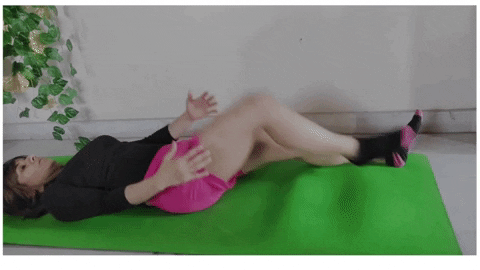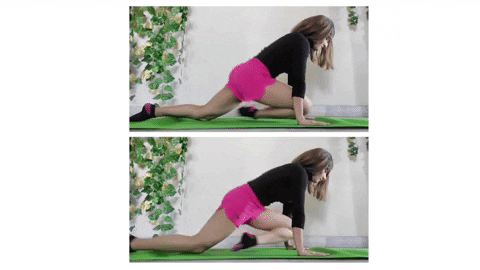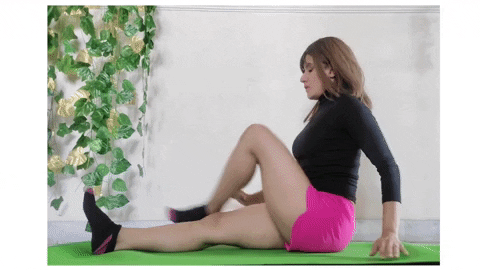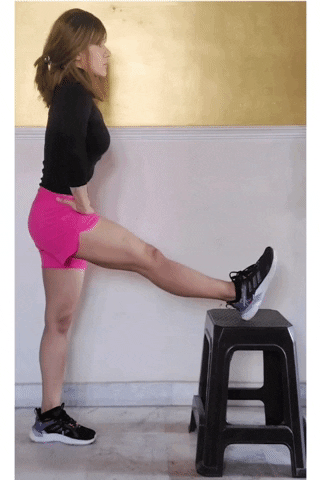Introduction • Causes • Figure 4 • Knee to Chest • Pigeon Pose • Spinal Twist • Seated 4 • Standing Hamstring • Standing Piriformis • Scissor Hamstring • Precautions • Yoga for sciatica

What is sciatica ?
Sciatica pain begins in your lower back and moves down your legs. The sciatic nerve is the longest and thickest nerve in the body. It starts with five nerves in the lower back that come together and form one nerve that runs through the buttocks and down the leg. Inflammation of the sciatic nerve is called sciatica. It can cause a burning or shooting pain in the buttocks or a pain that goes all the way down the leg. The pain usually occurs only on one side.

Sciatic nerve pain can be so excruciating and debilitating that you don’t even want to get off the couch. Sciatic pain will usually follow the path of the sciatic nerve in the affected leg. It happens when there’s a compression or irritation of a nerve anywhere along this pathway.
Common causes of sciatica can include:
a ruptured disk
narrowing of the spine canal (called spinal stenosis)
injury
Piriformis syndrome. Your piriformis muscle extends from your buttocks at the edge of your spine all the way to the top of your thigh at the back. Sometimes this muscle can spasm and trap the sciatic nerve, which is located nearby. This can result in sciatic pain.
Licensed physical therapist Mindy Marantz says that sciatica pain can occur for a variety of reasons. “Identifying what doesn’t move is the first step toward solving the problem,” she explains. Often, the most problematic body parts are the lower back and hips.
Dr. Mark Kovacs, a certified strength and conditioning specialist, adds that the best way to alleviate most sciatica pain is to do “any stretch that can externally rotate the hip to provide some relief.”

While it may seem counterintuitive, exercise is more effective in relieving sciatica pain than bed rest or staying active with daily physical activities.
While a short period of rest and limited movement may be necessary when the sciatica pain flares up, long periods of inactivity usually make the pain worse. With prescribed exercise, sciatica pain is relieved due to the changes in tissues.
Without exercise and movement, the back muscles and spinal structures become deconditioned (weak and stiff) and less able to support the back. The deconditioning can lead to further trauma and strain, which can cause additional pain.
STRETCHES
Let's look at the exercises :
Laying down ones-
Figure 4 STRETCH
The figure-4 stretch can help you open your hips. There are multiple versions of this stretch, but for purpose of relieving sciatic nerve pain, you can try this :
Lie flat on your back and bend both your knees.
Cross your right foot over your left thigh, moving your legs up toward the torso.
Hold the position for a moment and then repeat on the other side
It’s important not to force this stretch. Instead, allow gravity to bring your legs closer to your body more naturally, achieving a deeper stretch.

KNEE TO CHEST
This helps in loosening your gluteal and piriformis muscles, which can become inflamed and press against the sciatic nerve.
Lie on your back with your legs extended, and your feet flexed upward.
Bend your right leg and clasp your hands around the knee.
Gently pull your right leg across your body toward your right shoulder. Hold it there for 30 seconds. Remember to pull your knee only as far as it will comfortably go. You should feel a relieving stretch in your muscle, not pain.
You can also try right knee to left shoulder.
Push your knee, so your leg returns to its starting position.
Repeat for a total of 3 reps, then switch legs.

PIGEON POSE STRETCH
Kneel on the floor on all fours.
Pick up your right leg and move it forward on the ground in front of your body. Your lower leg should be on the ground, horizontal to the body. Your right foot should be in front of your left knee while your right knee stays to the right.
Stretch the left leg out all the way behind you on the floor, with the top of the foot on the ground and toes pointing back.
Shift your body weight gradually from your arms to your legs so that your legs are supporting your weight. Sit up straight with your hands on either side of your legs.
Take a deep breath. While exhaling, lean your upper body forward over your front leg. Support your weight with your arms as much as possible.
Repeat on the other side.

SPINAL TWIST STRETCH
Sciatica pain is triggered when vertebrae in the spine compress. This stretch helps create space in the spine to relieve pressure on the sciatic nerve.
Sit on the ground with your legs extended straight out with your feet flexed upward.
Bend your right knee and place your foot flat on the floor on the outside of your opposite knee.
Place your left elbow on the outside of your right knee to help you gently turn your body toward the right.
Hold for 30 seconds and repeat three times, then switch sides.

SEATED FIGURE 4 STRETCH
Sit on the floor or a chair with your legs out in front of you.
Bend your right leg, putting your right ankle on top of the left knee.
Lean forward and allow your upper body to reach toward your thigh.
Hold for 15-30 seconds. This stretches the glutes and lower back.
Repeat on the other side.

Let's try a few standing ones...
STANDING HAMSTRING STRETCH
This stretch can help ease pain and tightness in the hamstring caused by sciatica.
Place your right foot at or below your hip level on an elevated surface. This could be a chair, ottoman, or step on a staircase. Flex your foot, so your toes and leg are straight. If your knee tends to hyperextend, keep a slight bend in it.
Bend your body forward slightly toward your foot. The further you go, the deeper the stretch. Don’t push so far that you feel pain.
Release the hip of your raised leg downward as opposed to lifting it up. If you need help easing your hip down, loop a yoga strap or long exercise band over your right thigh and under your left foot.
Hold for at least 30 seconds, then repeat on the other side.

STANDING PIRIFORMIS STRETCH
This is another standing stretch that can help with sciatica pain. You can do this without support if you’re able, but it can be hard to balance. Instead, you can also stand against a wall and place your feet about 24 inches from the wall.

Put your painful leg over the knee of your other leg while standing. Bend your standing leg and try to make the number 4 with your hips lowered to the ground at a 45-degree angle.
Bend your waist and swing your arms while holding your back straight. Stay in the position for 30-60 seconds.
Switch legs and repeat.

SCISSOR HAMSTRING STRETCH
The ischial tuberosity, also known as the sit or sitz bones, begins at the ischium, which is one of the parts that make up the pelvic girdle along with the ilium and the pubis.
The hamstring muscles attach to the ischial tuberosity via the sacrotuberous ligament (STL). When they are tight, hamstring muscles may mimic sciatica symptoms.

This stretch can help loosen those hamstring muscles, helping relieve their pressure on the sciatic nerve. It may help to do this exercise daily.
Place your right foot about 3 feet behind your left foot.
Pull your hips forward and push your shoulders back, but your right hip shouldn’t be farther forward than your left hip. A mirror may help make a judgment on this.
Put your hands on your hips. You may use a chair for balance if you need it.
Push your torso a bit over your front leg by bending your waist while keeping your back straight. Keep your weight on your front leg.
Keep this position for 5 to 10 seconds, then repeat the stretch with the opposite leg. Do the stretch for each leg 3 to 5 times.

PRECAUTIONS
Since sciatica has various causes, one exercise program doesn't work for everyone. Never force yourself through an exercise that doesn't feel right. Instead, focus on finding ones that work for you. As you improve, you may be able to do some movements that didn't work at first. Still, being consistent with your program is more important than ramping up the difficulty. You shouldn’t assume that you’ll be as flexible as the exercises ideally call for. Don’t think that because of what you see on YouTube or TV, you can get into these positions. Most people who demonstrate the exercises have great flexibility and have been doing it for years. If you have any kind of pain, you should stop.”
If you have other health conditions, you should talk to your doctor before trying these exercises for sciatica. If you experience increased pain after exercising, see your doctor
Give it a try -
20 min YIN class, gentle and easy for releasing sciatica and for back pain.